Limits and Derivatives : Notes and Study Materials -pdf
CBSE Class 11 Maths Notes Chapter 13 Limits and Derivatives
Limit
Let y = f(x) be a function of x. If at x = a, f(x) takes indeterminate form, then we consider the values of the function which is very near to a. If these value tend to a definite unique number as x tends to a, then the unique number so obtained is called the limit of f(x) at x = a and we write it as limx→af(x).
Left Hand and Right-Hand Limits
If values of the function at the point which are very near to a on the left tends to a definite unique number as x tends to a, then the unique number so obtained is called the left-hand limit of f(x) at x = a, we write it as
Existence of Limit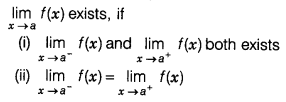
Some Properties of Limits
Let f and g be two functions such that both limx→af(x) and lim limx→ag(x) exists, then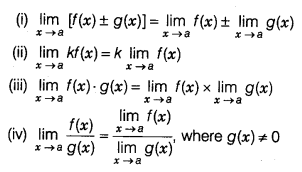
Some Standard Limits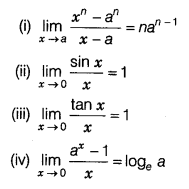

Derivatives
Suppose f is a real-valued function, then
Fundamental Derivative Rules of Function
Let f and g be two functions such that their derivatives are defined in a common domain, then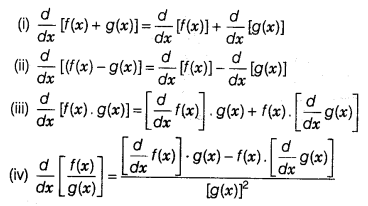
Some Standard Derivatives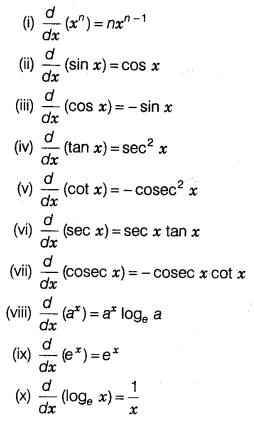
Limits and Derivatives Class 11 MCQs Questions with Answers
Question 1.
The value of the limit Limx→0 (cos x)cot2 x is
(a) 1
(b) e
(c) e1/2
(d) e-1/2
Answer
Answer: (d) e-1/2
Hint:
Given, Limx→0 (cos x)cot² x
= Limx→0 (1 + cos x – 1)cot² x
= eLimx→0 (cos x – 1) × cot² x
= eLimx→0 (cos x – 1)/tan² x
= e-1/2
Question 2.
The value of limit Limx→0 {sin (a + x) – sin (a – x)}/x is
(a) 0
(b) 1
(c) 2 cos a
(d) 2 sin a
Answer
Answer: (c) 2 cos a
Hint:
Given, Limx→0 {sin (a + x) – sin (a – x)}/x
= Limx→0 {2 × cos a × sin x}/x
= 2 × cos a × Limx→0 sin x/x
= 2 cos a
Question 3.
Limx→-1 [1 + x + x² + ……….+ x10] is
(a) 0
(b) 1
(c) -1
(d) 2
Answer
Answer: (b) 1
Hint:
Given, Limx→-1 [1 + x + x² + ……….+ x10]
= 1 + (-1) + (-1)² + ……….+ (-1)10
= 1 – 1 + 1 – ……. + 1
= 1
Question 4.
The value of Limx→01 (1/x) × sin-1 {2x/(1 + x²) is
(a) 0
(b) 1
(c) 2
(d) -2
Answer
Answer: (c) 2
Hint:
Given, Limx→0 (1/x) × sin-1 {2x/(1 + x²)
= Limx→0 (2× tan-1 x)/x
= 2 × 1
= 2
Question 5.
Limx→0 log(1 – x) is equals to
(a) 0
(b) 1
(c) 1/2
(d) None of these
Answer
Answer: (a) 0
Hint:
We know that
log(1 – x) = -x – x²/2 – x³/3 – ……..
Now,
Limx→0 log(1 – x) = Limx→0 {-x – x²/2 – x³/3 – ……..}
⇒ Limx→0 log(1 – x) = Limx→0 {-x} – Limx→0 {x²/2} – Limx→0 {x³/3} – ……..
⇒ Limx→0 log(1 – x) = 0
Question 6.
Limx→0 {(ax – bx)/ x} is equal to
(a) log a
(b) log b
(c) log (a/b)
(d) log (a×b)
Answer
Answer: (c) log (a/b)
Hint:
Given, Limx→0 {(ax – bx)/ x}
= Limx→0 {(ax – bx – 1 + 1)/ x}
= Limx→0 {(ax – 1) – (bx – 1)}/ x
= Limx→0 {(ax – 1)/x – (bx – 1)/x}
= Limx→0 (ax – 1)/x – Limx→0 (bx – 1)/x
= log a – log b
= log (a/b)
Question 7.
The value of limy→0 {(x + y) × sec (x + y) – x × sec x}/y is
(a) x × tan x × sec x
(b) x × tan x × sec x + x × sec x
(c) tan x × sec x + sec x
(d) x × tan x × sec x + sec x
Answer
Answer: (d) x × tan x × sec x + sec x
Hint:
Given, limy→0 {(x + y) × sec (x + y) – x×sec x}/y
= limy→0 {x sec (x + y) + y sec (x + y) – x×sec x}/y
= limy→0 [x{ sec (x + y) – sec x} + y sec (x + y)]/y
= limy→0 x{ sec (x + y) – sec x}/y + limy→0 {y sec (x + y)}/y
= limy→0 x{1/cos (x + y) – 1/cos x}/y + limy→0 {y sec (x + y)}/y
= limy→0 [{cos x – cos (x + y)} × x/{y×cos (x + y)×cos x}] + limy→0 {y sec (x + y)}/y
= limy→0 [{2sin (x + y/2) × sin(y/2)} × 2x/{2y×cos (x + y)×cos x}] + limy→0 {y sec (x + y)}/y
= limy→0 {sin (x + y/2) × limy→0 {sin(y/2)/(2y/2)} × limy→0 { x/{y×cos (x + y)×cos x}] + sec x
= sin x × 1 × x/cos² x + sec x
= x × tan x × sec x + sec x
So, limy→0 {(x + y) × sec (x + y) – x×sec x}/y = x × tan x × sec x + sec x
Question 8.
Limy→∞ {(x + 6)/(x + 1)}(x+4) equals
(a) e
(b) e³
(c) e5
(d) e6
Answer
Answer: (c) e5
Hint:
Given, Limy→∞ {(x + 6)/(x + 1)}(x + 4)
= Limy→∞ {1 + 5/(x + 1)}(x + 4)
= eLimy→∞ 5(x + 4)/(x + 1)
= eLimy→∞ 5(1 + 4/x)/(1 + 1/x)
= e5(1 + 4/∞)/(1 + 1/∞)
= e5/(1 + 0)
= e5
Question 9.
The derivative of [1+(1/x)] /[1-(1/x)] is
(a) 1/(x-1)²
(b) -1/(x-1)²
(c) 2/(x-1)²
(d) -2/(x-1)²
Answer
Answer: (d) A
Hint:
Let y = [1+(1/x)] /[1-(1/x)]
then dy/dx = [{1-(1/x)}*(-1/x²)]/[{1+(1/x)}*(1/x²)]
= (1/x²) [(1/x) -1 – 1 – (1/x)]/[1-(1/x)]²
= [-2/x²]/[(x-1)/x]²
= -2/(x-1)²
Question 10.
The expansion of log(1 – x) is
(a) x – x²/2 + x³/3 – ……..
(b) x + x²/2 + x³/3 + ……..
(c) -x + x²/2 – x³/3 + ……..
(d) -x – x²/2 – x³/3 – ……..
Answer
Answer: (d) -x – x²/2 – x³/3 – ……..
Hint:
log(1 – x) = -x – x²/2 – x³/3 – ……..
Question 11.
If f(x) = x × sin(1/x), x ≠ 0, then Limx→0 f(x) is
(a) 1
(b) 0
(c) -1
(d) does not exist
Answer
Answer: (b) 0
Hint:
Given, f(x) = x × sin(1/x)
Now, Limx→0 f(x) = Limx→0 x × sin(1/x)
⇒ Limx→0 f(x) = 0
Question 12.
The value of Limn→∞ {1² + 2² + 3² + …… + n²}/n³ is
(a) 0
(b) 1
(c) -1
(d) n
Answer
Answer: (a) 0
Hint:
Given, Limn→∞ {1² + 2² + 3² + …… + n²}/n³
= Limn→∞ [{n×(n + 1)×(2n + 1)}/6]/{n(n + 1)/2}²
= Limn→∞ [{n×n×n ×(1 + 1/n)×(2 + 1/n)}/6]/{n × n ×(1 + 1/n)/2}²
= Limn→∞ [{n³ ×(1 + 1/n)×(2 + 1/n)}/6]/{n² ×(1 + 1/n)/2}²
= Limn→∞ [{(1 + 1/n)×(2 + 1/n)}/6]/[n4 × {(1 + 1/n)/2}²]
⇒ Limn→∞ [{(1 + 1/n)×(2 + 1/n)}/6]/[n × {(1 + 1/n)/2}²]
= [{(1 + 1/∞)×(2 + 1/∞)}/6]/[∞×{(1 + 1/∞)/2}²
= [{(1 + 0)×(2 + 0)}/6]/∞ {since 1/∞ = 0}
= {(1 × 2)/6}/∞
= (2/6)/∞
= (1/3)/∞
= 0
So, Limn→∞ {1² + 2² + 3² + …… + n²}/n³ = 0
Question 13.
The value of Limn→∞ (sin x/x) is
(a) 0
(b) 1
(c) -1
(d) None of these
Answer
Answer: (a) 0
Hint:
Limn→∞ (sin x/x) = Limy→0 {y × sin (1/y)} = 0
Question 14.
The value of Limx→0 ax is
(a) 0
(b) 1
(c) 1/2
(d) 3/2
Answer
Answer: (b) 1
Hint:
We know that
ax = 1 + x/1! × (log a) + x²/2! × (log a)² + x³/3! × (log a)³ + ………..
Now,
Limx→0 ax = Limx→0 {1 + x/1! × (log a) + x²/2! × (log a)² + x³/3! × (log a)³ + …}
⇒ Limx→0 ax = Limx→0 1 + Limx→0 {x/1! × (log a)} + Limx→0 {x² /2! × (log a)²}+ ………
⇒ Limx→0 ax = 1
Question 15.
Let f(x) = cos x, when x ≥ 0 and f(x) = x + k, when x < 0 Find the value of k given that Limx→0 f(x) exists.
(a) 0
(b) 1
(c) -1
(d) None of these
Answer
Answer: (b) 1
Hint:
Given, Limx→0 f(x) exists
⇒ Limx→0 – f(x) = Limx→0 + f(x)
⇒ Limx→0 (x + k) = Limx→0 cos x
⇒ k = cos 0
⇒ k = 1
Question 16.
The value of Limx→0 (1/x) × sin-1 {2x/(1 + x²) is
(a) 0
(b) 1
(c) 2
(d) -2
Answer
Answer: (c) 2
Hint:
Given, Limx→0 (1/x) × sin-1 {2x/(1 + x²)
= Limx→0 (2 × tan-1 x)/x
= 2 × 1
= 2
Question 17.
Limx→0 sin (ax)/bx is
(a) 0
(b) 1
(c) a/b
(d) b/a
Answer
Answer: (c) a/b
Hint:
Given, Limx→0 sin (ax)/bx
= Limx→0 [{sin (ax)/ax} × (ax/bx)]
⇒ (a/b) Limx→0 sin (ax)/ax
= a/b
Question 18.
The value of the limit Limx→0 {log(1 + ax)}/x is
(a) 0
(b) 1
(c) a
(d) 1/a
Answer
Answer: (c) a
Hint:
Given, Limx→0 {log(1 + ax)}/x
= Limx→0 {ax – (ax)² /2 + (ax)³ /3 – (ax)4 /4 + …….}/x
= Limx→0 {ax – a² x² /2 + a³ x³ /3 – a4 x4 /4 + …….}/x
= Limx→0 {a – a² x /2 + a³ x² /3 – a4 x³ /4 + …….}
= a – 0
= a
Question 19.
If f(x) = (x + 1)/x then df(x)/dx is
(a) 1/x
(b) -1/x
(c) -1/x²
(d) 1/x²
Answer
Answer: (c) -1/x²
Hint:
Given, f(x) = (x + 1)/x
Now, df(x)/dx = d{(x + 1)/x}/dx
= {1 × x – (x + 1)×1}/x²
= (x – x – 1)/x²
= -1/x²
Question 20.
Limx→0 (ex² – cos x)/x² is equals to
(a) 0
(b) 1
(c) 2/3
(d) 3/2
Answer
Answer: (d) 3/2
Hint:
Given, Limx→0 (ex² – cos x)/x²
= Limx→0 (ex² – cos x -1 + 1)/x²
= Limx→0 {(ex² – 1)/x² + (1 – cos x)}/x²
= Limx→0 {(ex² – 1)/x² + Limx→0 (1 – cos x)}/x²
= 1 + 1/2
= (2 + 1)/2
= 3/2